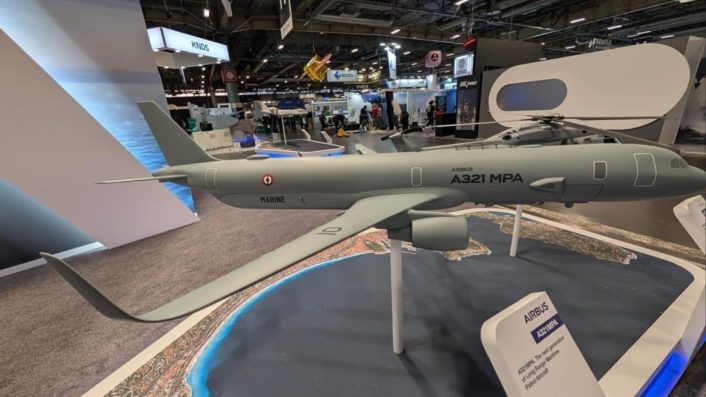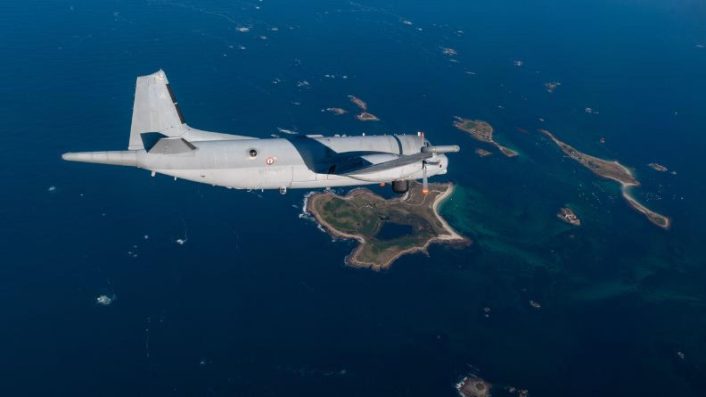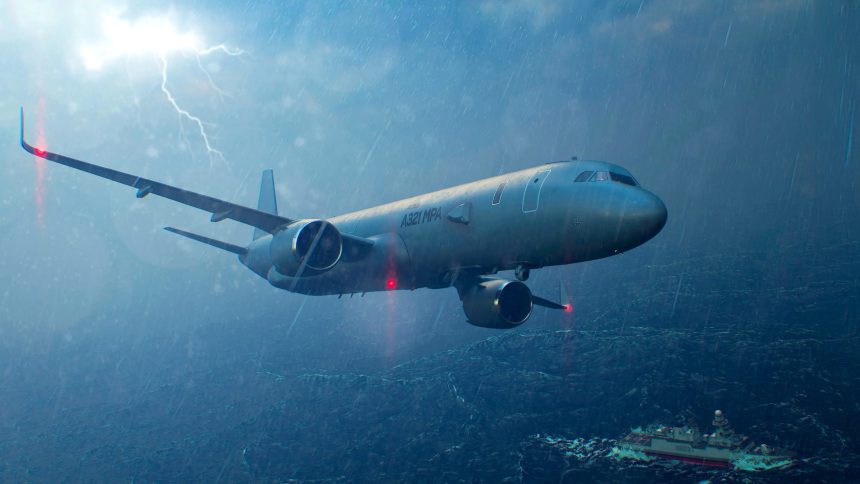Based on the A321XLR civilian airliner, the A321MPA features conformal radar arrays, MAD, ESM and a large weapons bay as part of its ASW modifications. Dassault Aviation also pitched a proposal based on the Falcon 10X.
European defense major Airbus unveiled a scale model of the new A321 MPA (Maritime Patrol Aircraft) at the Euronaval exhibition last week. The new concept, which marks a change from the Airbus A320M3A (Modular Multi-Mission Aircraft) unveiled during the 2018 edition of the exhibition, follows a French government project to acquire new MPAs.
A day after the display, La Tribune claimed that the country has already chosen the A321 MPA as a part of the Patmar (Patrouille Maritime) program for acquiring new generation fixed-wing maritime patrol aircraft. Dassault Aviation was the other contender for Patmar, which aims to replace the French Navy’s (Marine Nationale) fleet of 22 Breguet Atlantique ATL2s after 2030.
Blog – #Euronaval 2024 – A321 version MPA par @AirbusDefence – Le futur de la patrouille maritime pour la @MarineNationale et à l’export ?https://t.co/HuS13BHnuh#Euronaval2024 #AvGeek https://t.co/oP79fDdwfD pic.twitter.com/bJfW1h6hZm
— FdeStV (@Marsattaqueblog) November 5, 2024
The report added that France’s Ministry of the Armed Forces chose the proposal from Airbus Defense and Space over Dassault’s. Based on the A321XLR (Extra Long Range) passenger plane, Airbus Defence and Space describes it as the “next generation Long Range MPA.” Airbus has partnered with Thales for supplying the electronics and avionics.
However, as Naval News later revealed in an interview with an Airbus representative, the company is still awaiting a final decision from the French defense officials. Neither Dassault or Airbus made an official announcement.
Breaking News: The Airbus A321MPA has been chosen as the French Navy’s next-generation long-range maritime patrol aircraft. pic.twitter.com/kLLC5ANCgY
— International Defence Analysis (@Defence_IDA) November 10, 2024
Design configuration
The scale model shows the twin-engine airliner outfitted with an array of sensors, including two fairings on the side of the fuselage for radar arrays. The underside also has some pretty evident differences, with the wing to body fairings extended towards the rear fuselage, creating a squared extension for more than half the length of the aircraft to be used as weapon bays for sonobuoys and torpedoes.
The dorsal side is equipped with two fairings, possibly for SATCOMs, five blade antennas, as well as one each V/UHF and HF antennas. An EO (Electro-Optical) ball turret is also installed below the cockpit, while the tail cone shows a configuration similar to other MPA aircraft which include ESM (Electronic Support Measures), MAWS (Missile Approach Warning Systems), RWR (Radar Warning Receivers) and magnetic anomaly detector (MAD) sensors and antennas.
The possibility of the plane having some ELINT (Electronic Intelligence) capabilities also cannot be discounted, as there is a broad need today for special mission and support aircraft to have some all-aspect ISR (Intelligence, Surveillance and Reconnaissance) systems. The model does not show an aerial refueling probe, as well as external hardpoints for missiles which appear to be currently not planned. However, it must be remembered that this is only a scale model of the concept design, with Airbus stating it is trying to limit the required structural modifications to the aircraft.

Airbus official sheds more light
Naval News interviewed Airbus Defence and Space’s Alexis Latty, the company’s manager for French Navy programs, at the exhibition booth, who said that the company developed the A321 MPA concept after the French DGA (Directorate General of Armaments) commissioned an 18-month long feasibility study. Airbus is utilizing its experience with converting commercial assets into military aircraft, like the A330 MRTT (Multi-Role Tanker Transport).
Since the A231, which is part of the A320 family of narrow body short to medium-range passenger airliners introduced as recent as 2010 with the New Engine Option (NEO) variants, assures a 40-year lifespan along with easy upgradability and maintainability. The newer design also allows adopting future, next-generation equipment over the airframe’s lifespan.
While this was neither implied, nor explicitly stated, the possibility that the Marine Nationale might someday envision its support and special mission planes like MPAs to control collaborative UAVs/UCAVs cannot be discounted. The final requirements, however, have not been released yet.
Latty explained that Thales will provide the entire sensor suite, with a key element being new conformal radar arrays located in the side fairings. The aircraft is expected to provide better performance than the ATL2, with the baseline A321XLR having a range of 4,700 nm and endurance of 11 hours.
French contest for future MPA
Opex360 reported that Airbus’ competitor in the MPA program, Dassault Aviation, was developing a concept based on the Falcon 10X, with a range of 14,000 km. The DGA study, ordered in Jan. 2023, that prompted both proposals required an “economically interesting solution meeting the operational needs of the French Navy in the post-2030 horizon.”
The 2024 edition of EURONAVAL just kicked off!
Airbus has a major presence showcasing its latest innovations and technologies to make oceans safer. ➡️Featuring Eurodrone, Aliaca & VSR700 drones, C295 & A321 MPA aircraft and @AirbusHeli NH90 & 160M, Deckfinder, Styris and other… pic.twitter.com/S6k4VhJmx3
— Airbus Defence (@AirbusDefence) November 4, 2024
The DGA wants the new MPA to innovate with the “improvement of sensors, means of communication, the introduction of logic based on artificial intelligence or the integration of weaponry, in particular the future anti-ship missile.” The latter requirement refers to MBDA’s Future Anti-Ship Missile/Future Cruise Missile, also known with the French acronym FMAN/FMC or the English one FC/ASW.
Opex360 also mentioned that the results of the study have “still not been communicated” by the DGA, although noting that La Tribune is reporting that the two companies have been notified. Among the reasons stated behind Airbus’s speculated selection over Dassault’s Falcon 10X-based solution are the capability to carry the FMAN anti-ship missile and the possibility of the A321 to carry a second crew for long-duration missions.
Latty had pointed out earlier that the A321 MPA was developed with the goal of requiring minimum, optimal changes to the airframe to keep the costs low. However, the costs related to a platform derived from the A321XLR airliner are still higher than the ones of the smaller Falcon 10X, which trades payload for range.

Breguet Atlantique ATL2
Commissioned in the early 1990s, the DGA describes the ATL2 as a very long-range, twin-engine, multi-mission aircraft. The twin-turboprop engine plane can perform “low to high intensity” anti-submarine warfare, anti-ship and intelligence gathering missions. The Atlantique also operates in support of ground troops and contributes to the State’s actions at sea.
Un avion de PatMar comme le P8 évolue a différentes altitudes au cours d’un même vol, cela permet de capter les émissions radar des navires présents, de détecter des sous-marins, bref de dresser une situation tactique de la zone.
En France c’est l’Atlantique 2 (🥰) qui a ce rôle. pic.twitter.com/Fs8RCXVic4
— Xavier Tytelman (@PeurAvion) April 20, 2022
The ongoing upgrade project to the standard 6, which involves a total of 18 aircraft and is scheduled to be completed by 2025, “restores the aircraft’s performance, particularly in underwater warfare.” The new equipment comprises the new Searchmaster radar, featuring an active antenna technology developed by Thales for the Rafale.









